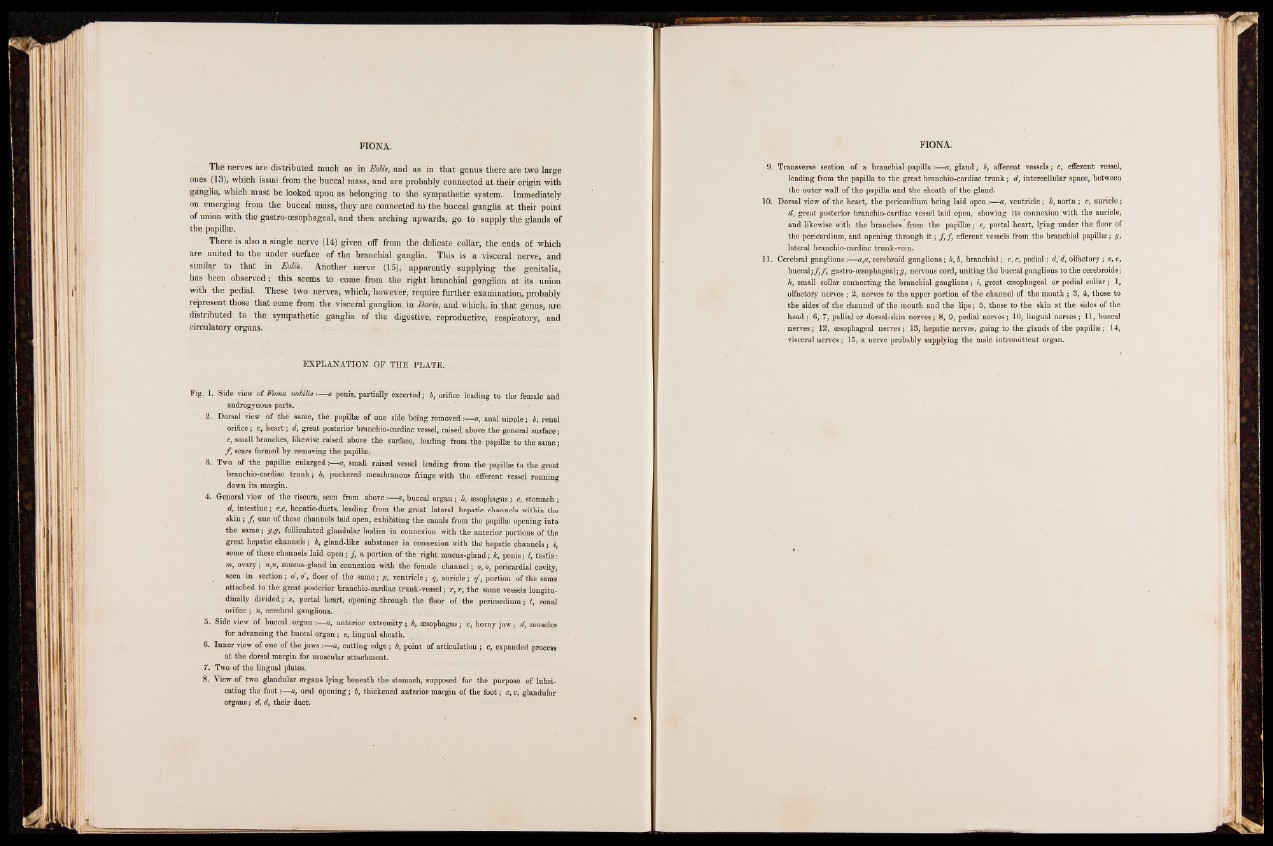
The nerves are distributed much as in Eolis, and as in th a t genus thére are two large
on és (13), which issue from the buccal mass, and are probably connected a t their origin with
ganglia, which must be looked upon as belonging to th é sympathetic system. Immediately
on emerging from the buccal mdss, they are connected to the buccal ganglia a t th eir point
of union with th e gastro-oesophageal, and then arching upwards, go to supply thé glands of
the papillae.
There is also a single nerve (14) given off from the delicate collar, the ends of which
are united to th e under surface of the branchial ganglia. This is a visceral nerve, and
similar to th a t in Eolis. Another nerve (l5 ), apparently supplying th e genitalia,
has been observed; this seems to come from th e rig h t branchial ganglion a t its union
with the pedial. These two nerves; which, however, require further examination, probably
represent those th a t come from the viscefal ganglion in Doris, and which, in th a t genus, are
distributed to th é sympathetic ganglia of th e digestive', reproductive, respiratory, and
circulatory organs.
EXPLANATION OF THE PLATE.
Fig. 1. Side view of Fiona nobilis;— a penis, partially excerted; b, orifice leading to the female and
androgynous parts.
2. Dorsal view of the same, the papillae of one side being removed:—-a, anal nipple; b, renal
orifice; c, heart; d, great posterior branchio-cardiac vessel, raised above the general surface;
e, small branches, likewise raised above the surface, leading from the papilhe to the same;
f , scars formed by removing the papillae.
3. Two of the papillae enlarged:—«, small raised vessel leading from the papillm to the great
branchio-cardiac trunk; b, puckered membranous fringe with the efferent vessel running
down its margin.
4. General view of the viscera, seen from above:—a, buccal organ; b, oesophagus; c, stomach;
d, intestine; e,e, hepatic-ducts, leading from the great lateral hepatic channels within the
skin} f) one of these channels laid open, exhibiting the canals from the papillae opening into
the same; g,g, folliculated glandular bodies in connexion with the anterior portions of the
great hepatic channels; h, gland-like substance in connexion with the hepatic channels; i,
some of these channels laid open; j , a portion of the right mucus-gland; k, penis; l, testis:
m, ovary; n,n, mucus-gland in connexion with the female channel; o, o, pericardial cavity,
seen in section; o', o', floor of the same; p, ventricle; q, auricle; q', portion of thé same
attached to the great posterior branchio-cardiac trunk-vessel; r, r, the same vessels longitudinally
divided; s, portal heart, opening through the floor of the pericardium; t, renal
orifice; u, Cerebral ganglions.
5. Side view of buccal organ:—a, anterior extremity ; b, oesophagus; c, horny jaw; d, muscles
for advancing the buccal organ; e, lingual sheath.
6. Inner view of one of the jaws:—a, cutting edge; b, point of articulation ; c, expanded process
at the dorsal margin for muscular attachment.
7. Two of the lingual plates.
8. View of two glandular organs lying beneath the stomach, supposed for the purpose of lubricating
the foot:—a, oral opening; b, thickened anterior margin of the foot; c, c, glandular
organs; d, d, their duct.
9. Transverse section of a branchial papilla:—a, gland; b, afferent vessels; c, efferent vessel,
leading from the papilla to the great branchio-cardiac tru n k ; d, intercellular space, between
the outer wall of the papilla and the sheath of the gland.
10. Dorsal view of the heart, the pericardium being laid open:—a, ventricle; b, aorta; c, auricle;
d, great posterior branchio-cardiac vessel laid open, showing its connexion with the auricle,
and likewise with the branches from the papillae; e, portal heart, lying under the floor of
the pericardium, and opening through i t ; f f , efferent vessels from the branchial papillae; g,
lateral branchio-cardiac trunk-vein.
11. Cerebral ganglions -— a,a, cerebroid ganglions; b, b, branchial; c, c, pedial; d,‘d, olfactory; e, e,
buccal;/,^ gastro-oesophageal; g, nervous cord, uniting the buccal ganglions to the cerebroids;
h, small collar connecting the branchial ganglions; i, great oesophageal or pedial collar; 1,
olfactory nerves ; 2, nerves to the upper portion of the channel of the mouth; 3, 4, those to
the sides of the channel of the mouth and the lips; 5, those to the skin at the sides of the
head; 6, 7, pallial or dorsal-skin nerves; 8, 9, pedial nerves; 10, lingual nerves; 11, buccal
nerves; 12, oesophageal nerves; 13, hepatic nerves, going to the glands of the papillae; 14,
visceral nerves; 15, a nerve probably supplying the male intromittent organ.